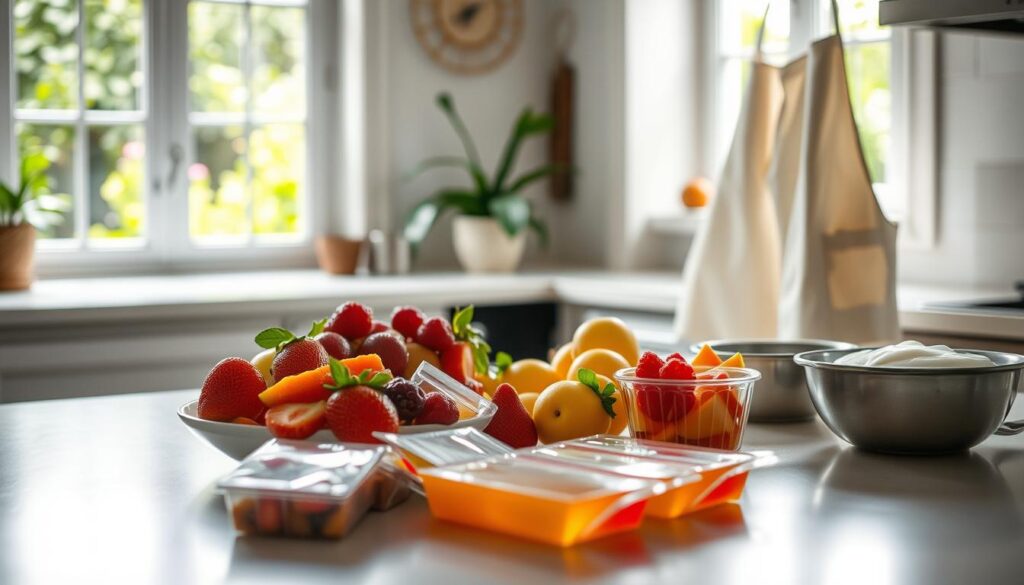Cold Jelly Cake: A Chilled Delight for Any Occasion
Are you looking for a dessert that’s both refreshing and visually stunning? Imagine a treat that combines the light, fluffy texture of cake with the bouncy, coolness of jelly. This unique dessert is not only a delight to the palate but also a feast for the eyes.
The cold jelly cake is a versatile dessert that can be customized with different flavors and colors, making it perfect for any occasion, from casual gatherings to elegant dinner parties. Its make-ahead nature and the ability to be prepared in advance make it an ideal choice for entertaining.
Preparing this dessert involves making the cake base, preparing the jelly mixture using agar agar, and assembling the layers to achieve the perfect balance of textures. Understanding the science behind setting the jelly is key to achieving the right consistency.
Key Takeaways
- The cold jelly cake offers a unique textural experience with its combination of cake and jelly layers.
- It’s highly customizable with different flavors, colors, and presentations.
- The dessert is make-ahead friendly, ideal for entertaining.
- Understanding the science behind gelatin or agar setting is crucial.
- The visual appeal of the dessert is impressive, with clear, colorful jelly layers contrasting against soft cake.
What is a Cold Jelly Cake?
Cold jelly cake is a refreshing dessert that combines the lightness of cake with the bounciness of jelly. This unique dessert is perfect for any occasion, offering a delightful blend of textures and flavors that will leave you wanting more. The combination of fluffy cake and smooth, bouncy jelly creates a uniquely satisfying mouthfeel that standard cakes simply can’t provide.

Origins and Popularity
Cold jelly cakes have gained popularity worldwide due to their refreshing nature and make-ahead convenience. Originating from traditional jelly desserts, cold jelly cakes have evolved into a modern dessert favorite, especially during summer gatherings or as a light dessert following a heavy meal. Their popularity stems from their ability to be prepared in advance, reducing day-of stress when entertaining guests.
Types of Cold Jelly Cakes
There are various types of cold jelly cakes, each offering a unique twist on the classic recipe. You can customize your cold jelly cake by adapting flavors, colors, and presentations to suit any occasion or preference. From fruit-infused jelly to cream-based cakes, the possibilities are endless, making cold jelly cakes a versatile dessert option.
Why You’ll Love This Recipe
This cold jelly cake recipe is highly customizable and allows you to prepare it well in advance. The visual impact of a well-made cold jelly cake guarantees impressed reactions before anyone even tastes it. You’ll love this recipe because it’s exceptionally refreshing, making it perfect for summer gatherings or as a light dessert. The make-ahead nature of this recipe reduces day-of stress when entertaining guests.
| Benefits | Description |
|---|---|
| Refreshing | Perfect for summer gatherings or as a light dessert |
| Make-Ahead Friendly | Reduces day-of stress when entertaining guests |
| Customizable | Adapt flavors, colors, and presentations to suit any occasion |
Essential Ingredients and Equipment
To create a stunning Cold Jelly Cake, you’ll need to gather a few essential ingredients and some specific equipment. The quality of your ingredients and the appropriateness of your tools will significantly impact the final result.
Cake Components
The base of your Cold Jelly Cake is just as important as the jelly topping. You’ll need ingredients like flour, sugar, and eggs to make a traditional cake. The type of cake you choose can vary; for instance, a vanilla or vanilla sponge cake works well. Ensure your cake is baked and cooled properly before proceeding.
Jelly Ingredients
For the jelly layer, you’ll need jelly or gelatin, sugar, and water. You can flavor your jelly with fruit juices or extracts. The ratio of gelatin to liquid is crucial; typically, 1 teaspoon of gelatin is used per cup of liquid. Adjust the sugar to taste.
Tools You’ll Need
Having the right equipment is vital. You’ll need a mixing bowl, a measuring cup, and a teaspoon for accurate measurements. A cake pan and a refrigerator set at the right temperature are also essential. Ensure your kitchen is at room temperature for easier mixing.
Ingredient Substitutions
Some ingredients can be substituted to cater to different dietary needs. For instance, agar agar can replace gelatin for a vegetarian version. You can also use coconut cream instead of dairy cream for a different flavor profile. Adjusting the sugar content or using alternatives like honey or maple syrup can also be considered.
| Ingredient | Substitution | Notes |
|---|---|---|
| Gelatin | Agar Agar | Use 1 teaspoon agar for 1 tablespoon gelatin |
| Dairy Cream | Coconut Cream | Provides a different flavor profile |
| Sugar | Honey or Maple Syrup | Adjust liquid ratios accordingly |
Using day-old cake can actually be beneficial as it absorbs less moisture and maintains its structure better. Whether you’re making a simple or elaborate Cold Jelly Cake, having the right ingredients and equipment is key to your success.
Making the Perfect Cold Jelly Cake
To make a cold jelly cake that’s both visually appealing and delicious, follow these steps carefully. The process involves several key components, including preparing the cake base, creating the jelly mixture, and assembling the cake.
Preparing the Cake Base
The foundation of a great cold jelly cake is its cake base. To prepare it, you’ll need to bake a sponge cake or a similar type of cake that can hold its shape when chilled. Ensure that the cake is completely cooled before proceeding to the next step. You can flavor the cake base with extracts like vanilla or almond to enhance the overall taste of the dessert.
Creating the Jelly Mixture
The jelly mixture is what gives the cold jelly cake its signature texture and flavor. To create it, you’ll need to mix gelatin or agar with a liquid, such as fruit juice or a flavored syrup, and then heat it gently until the gelatin dissolves. Be careful not to boil the mixture, as this can cause the jelly to become cloudy. Once the mixture is ready, allow it to cool slightly before pouring it over the cake base.

Assembly Techniques
Assembling the cold jelly cake requires some care to ensure that the layers adhere properly. Start by placing the cooled cake base in a mold or a springform pan. Pour the prepared jelly mixture over the cake, making sure to fill the mold to the top. If you’re using multiple layers, allow each layer to set before adding the next. This will help prevent the layers from mixing.
Chilling and Setting Tips
To ensure that your cold jelly cake sets properly, it’s crucial to chill it for the right amount of time. The cake should be refrigerated until the jelly is firm to the touch. Avoid over-chilling, as this can cause the cake to become too firm. If you’re having trouble getting the jelly to set, check that you’ve used enough gelatin or agar, and that the mixture wasn’t too hot when poured over the cake.
Troubleshooting Common Issues
Despite your best efforts, issues can still arise when making a cold jelly cake. Common problems include the jelly leaking into the cake, cloudy jelly, or jelly that’s too firm or too soft. To address these issues, refer to the following table:
| Issue | Cause | Solution |
|---|---|---|
| Jelly leaking into the cake | Improper sealing | Ensure the cake base is properly sealed |
| Cloudy jelly | Boiling or stirring while cooling | Reheat gently and cool undisturbed |
| Jelly too firm or too soft | Insufficient or excessive gelatin/agar | Adjust the gelatin/agar ratio |
| Jelly separates from the cake sides | Cake contraction | Brush the sides with a compatible liquid before assembly |
By following these tips and techniques, you can create a cold jelly cake that’s not only delicious but also visually appealing. For an added touch, consider using chocolate or other flavorings to enhance the cake’s flavor profile.
Serving and Enjoying Your Cold Jelly Cake
When it’s time to serve your cold jelly cake, a few simple techniques can make all the difference. To start, use a serrated knife and wipe it clean between cuts to ensure smooth, even slices. Allowing the cake to warm slightly at room temperature for 15-20 minutes before serving can enhance the texture contrast between the chilled jelly and the cake.
Garnishing your cold jelly cake can add both visual appeal and flavor. Consider using fresh fruit, whipped cream, or crushed cookies to complement your cake’s style. The flavor profile of your jelly cake will also guide your choice of beverage pairings; for instance, unsweetened tea pairs well with fruit-forward cakes, while coffee complements chocolate-based variations.
To maintain the optimal texture, especially in warm environments, keep the cake refrigerated until shortly before serving. When storing leftovers, promptly return the cake to the fridge and cover it loosely to prevent the jelly from drying out. By following these tips, you can enjoy your cold jelly cake at its best, whether it’s for a special occasion or a delightful everyday treat.
- For the best results, serve cold jelly cake within 2-3 days of preparation.
- Consider decorative techniques like mirror glazes or edible flowers for special occasions.
- When serving at events, maintain the cake’s temperature to preserve its texture.






